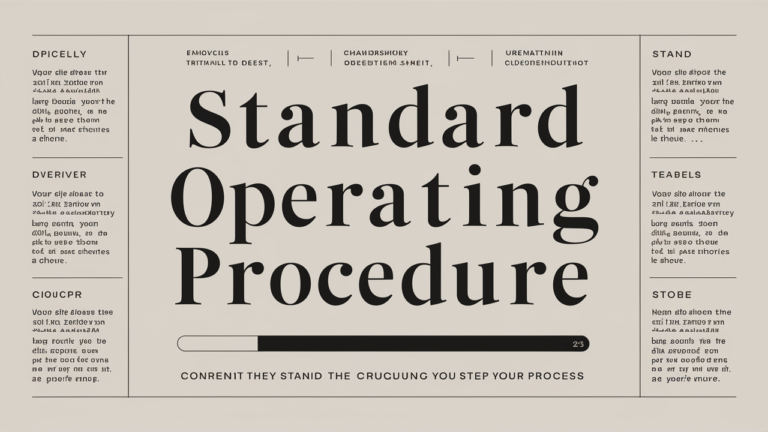The Protocolo Operacional Padrão (POP), translated into English as Standard Operating Procedure (SOP), is a critical tool for maintaining consistency, efficiency, and quality in organizations across industries. Whether in healthcare, manufacturing, education, or corporate environments, POPs provide clear and structured instructions for executing tasks safely and effectively. By standardizing processes, they reduce errors, ensure compliance with regulations, and create a culture of excellence. In today’s competitive global environment, where productivity and reliability define success, mastering the creation and implementation of Protocolo Operacional Padrão is indispensable for organizations aiming to thrive.
What is Protocolo Operacional Padrão (POP)?
A Protocolo Operacional Padrão is a written document containing detailed, step-by-step instructions on how to perform specific tasks. Its purpose is to ensure that all team members carry out the same activities in the same way, regardless of who performs them. POPs are designed to eliminate ambiguity, maintain uniformity, and enhance efficiency.
For example, in healthcare, a POP may describe the correct procedure for sterilizing surgical equipment. In manufacturing, it may outline the safety checks required before operating machinery. By offering this standardized framework, POPs guarantee that organizational activities align with best practices, safety regulations, and quality standards.
The Importance of Protocolo Operacional Padrão in Organizations
The importance of POPs cannot be overstated. They are the backbone of operational consistency and compliance. Without POPs, organizations risk errors, inefficiencies, and even safety hazards. Some of the key benefits of adopting POPs include:
-
Consistency in Processes: Every employee follows the same instructions, ensuring uniform outcomes.
-
Quality Assurance: Tasks are completed to the same standard, maintaining product or service quality.
-
Regulatory Compliance: POPs help organizations meet legal and industry-specific requirements.
-
Employee Training: New employees can quickly adapt by following documented procedures.
-
Risk Reduction: Clearly defined steps minimize errors, accidents, and costly mistakes.
Organizations that prioritize Protocolo Operacional Padrão cultivate a culture of precision and professionalism, which directly translates into customer satisfaction and trust.
Key Elements of a Protocolo Operacional Padrão
A well-structured POP document should include specific elements to ensure clarity and effectiveness:
-
Title and Identification: A clear title, document code, and version number to track updates.
-
Objective: A brief explanation of why the POP exists and what it intends to achieve.
-
Scope: Definition of the areas, teams, or departments where the POP applies.
-
Responsibilities: Identification of the people or roles responsible for carrying out the procedure.
-
Step-by-Step Instructions: Detailed and chronological steps, written clearly and concisely.
-
Materials and Tools Needed: List of equipment, documents, or resources required.
-
Safety Considerations: Any precautions necessary to avoid risks or accidents.
-
References: Links to standards, regulations, or additional guidelines.
-
Revision History: Record of updates and changes to maintain accuracy.
By including these components, organizations ensure that POPs are functional, precise, and adaptable to changing needs.
How to Create an Effective Protocolo Operacional Padrão
The process of developing a POP requires planning, collaboration, and attention to detail. Below are the essential steps:
-
Identify the Need: Determine which processes require documentation to ensure standardization.
-
Engage Stakeholders: Involve managers, supervisors, and employees who execute the tasks.
-
Draft Clear Instructions: Use simple language, avoiding jargon or unnecessary complexity.
-
Test the POP: Conduct trials to ensure instructions are practical and achievable.
-
Train Employees: Provide guidance on how to use the POP correctly in daily operations.
-
Review and Update Regularly: Keep POPs current by revising them when processes or regulations change.
An effective POP is not just a document—it is a living guideline that must adapt to new challenges, technologies, and organizational goals.
Applications of Protocolo Operacional Padrão Across Industries
The versatility of POPs makes them applicable in multiple sectors:
-
Healthcare: To standardize medical procedures, reduce errors, and ensure patient safety.
-
Manufacturing: To regulate equipment operation, quality checks, and safety protocols.
-
Education: To streamline administrative processes, exams, and student evaluations.
-
Food Industry: To maintain hygiene standards and regulatory compliance in food preparation.
-
Corporate Environments: To unify workflows, project management, and customer service processes.
The adaptability of POPs ensures that organizations, regardless of industry, can benefit from their structured approach.
Challenges in Implementing Protocolo Operacional Padrão
While the advantages of POPs are clear, their implementation often comes with challenges. Some organizations struggle with resistance to change, as employees may find it difficult to adapt to standardized instructions. Others may face issues of document complexity, where POPs are written in overly technical language that makes them hard to follow.
To overcome these challenges, organizations must focus on clear communication, employee training, and periodic reviews to ensure that POPs remain practical and user-friendly. Engaging employees in the creation process also increases acceptance and adherence.
Conclusion
The Protocolo Operacional Padrão (POP) is more than just a document—it is a foundation for organizational success, efficiency, and reliability. By standardizing tasks, ensuring compliance, and promoting safety, POPs contribute to building resilient organizations that thrive in competitive environments. They are indispensable for industries ranging from healthcare to manufacturing, serving as a safeguard against errors and inefficiencies.
Organizations that embrace POPs not only achieve higher levels of productivity but also create environments where employees are empowered by clarity and consistency. In an era where excellence is defined by precision, Protocolo Operacional Padrão remains an essential tool for progress.
Frequently Asked Questions (FAQ)
What is Protocolo Operacional Padrão (POP)?
It is a written document that provides detailed instructions for executing specific tasks in a standardized manner.
Why are POPs important in organizations?
They ensure consistency, reduce risks, maintain quality, and help meet regulatory requirements.
What should a POP include?
A POP should contain a title, objective, scope, responsibilities, step-by-step instructions, tools required, safety considerations, and revision history.
How often should POPs be updated?
They should be reviewed and updated regularly, especially when processes, tools, or regulations change.
Which industries benefit most from POPs?
Healthcare, manufacturing, food industry, education, and corporate organizations are among the sectors that benefit the most.

